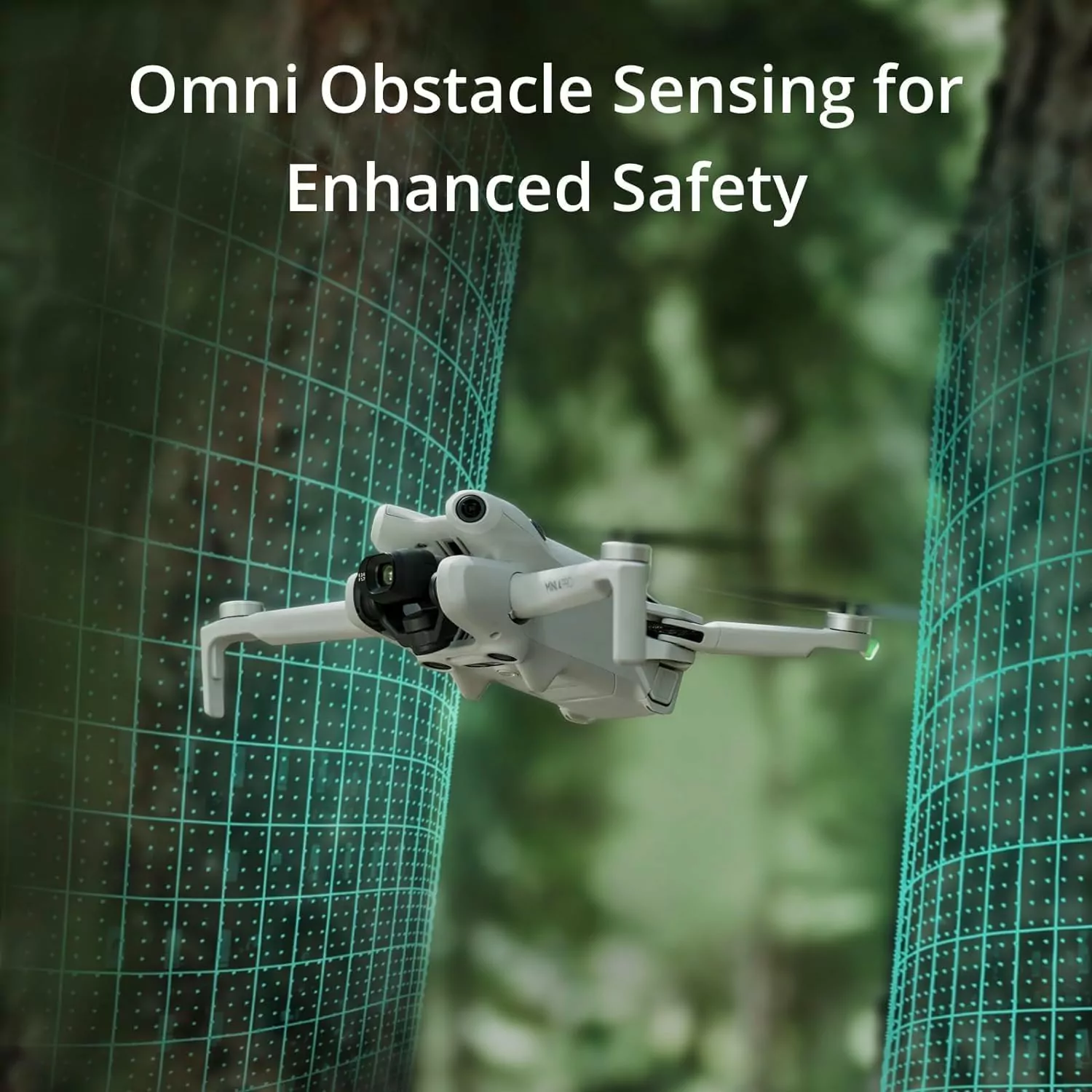Powerful and small, the DJI Mini 4 Pro boasts sophisticated capabilities that fit a range of uses. Although it shines in outside settings, many pilots question if it is feasible to operate this drone indoors. Indeed, you can fly the DJI Mini 4 Pro indoors, but it calls for careful preparation, particular tweaks, and a strong awareness of the drone’s capabilities and constraints.
Benefits of the DJI Mini 4 Pro for Indoor Flight
The Mini 4 Pro is a good competitor for indoor flying because of various characteristics:
- Small Compact Size: Its tiny form factor lets it more readily negotiate constrained locations and tight spaces than bigger drones.
- Vision Positioning System: Important for indoor areas where GPS signals may be weak or absent, the Vision Positioning System permits stable hovering at low altitudes (0.5 to 10 meters) free from reliance on GPS.
- Obstacle Avoidance Sensors: The forward, backward, and downward vision sensors of the drone enable the detection and avoidance of objects like walls, furniture, and people, lowering the chance of crashes.
- Omnidirectional Vision System and 3D Infrared Sensing: These cutting-edge technologies add extra obstacle detection and location data, enabling the indoor flying capability of the Mini 4 Pro.
Challenges and Limitations of Indoor Flight
Flying the DJI Mini 4 Pro inside presents certain difficulties and restrictions even with its outstanding capabilities that pilots should be aware of:

Restricted GPS Use
GPS signals find it difficult to pass through structures, producing poor or nonexistent reception indoors. This means pilots will have to rely more on manual control and the visual positioning system for stability and navigation, as some of the drone’s automated capabilities depending on GPS may not operate as intended.
Surface Requirements and Lighting
Effective operation of the visual positioning system depends on enough lighting and different surface textures. Pilots should ensure the flying environment has enough consistent lighting and avoid flying over uniform or reflecting surfaces.
Restricted Areas and Obstacle Hazards
Indoor locations often offer more limited places and challenges compared to outdoor settings. Even with the drone’s object avoidance sensors, pilots have to be particularly careful and fly slowly to reduce the risk of collisions.
Interferes with Vision Systems
The visual systems of the drone can be interfered with indoors by varying lighting conditions and surface textures. Pilots should be ready to manually control at any moment since the autonomous functions of their DJI Mini 4 Pro could not be as consistent as they are outside.
Use These Instructions to Maximize Your DJI Mini 4 Pro for Successful and Safe Indoor Flights:
- Link Propeller Guards: Always use propeller guards to shield walls, furniture, and people from harm or damage caused by spinning blades.
- Ensure Adequate Illumination: Make sure your flying area has enough, consistent lighting to allow the vision positioning system to function properly.
- Select Suitable Locations: Choose rooms or spaces large enough for movement and maintaining a safe distance from hazards. Avoid very small areas, particularly if you’re a less seasoned pilot.
- Calibrate Sensors: Before every indoor flight session, calibrate the sensors of your drone to ensure accurate object recognition and location.
- Change Control Sensitivity: Lower the control stick sensitivity in the DJI Fly app for more precise movements and simpler maneuvering in limited spaces.
Indoor Flight Recommended Settings
Change these DJI Fly app critical settings to maximize your Mini 4 Pro for indoor flying:
- Connectivity Interruption Scenario: Alter the preset “Return to Home” (RTH) setting to either “Hover” or “Land”. This prevents the drone from attempting to return to its launch location in case of signal loss, which could be hazardous when used indoors.
- RTH Settings: Adjust the default RTH setting in the advanced safety settings to “Hover” to prevent the drone from attempting to return to its home location in case any safety mechanisms are activated.
- Activate Payload Mode: If using propeller guards, activate this mode to adjust the drone’s flight characteristics, enhancing stability and control.
- Enable Visual Navigation Settings: Ensure the app enables the drone to use its vision systems for indoor obstacle avoidance and positioning.
Strategies for Safe and Powerful Indoor Flying
Keep these ideas in mind when flying your DJI Mini 4 Pro indoors:
- Maintain Visual Line of Sight: Ensure your drone is always within your visual line of sight to maintain awareness of its surroundings and control.
- Fly in Manual Mode: For more precise navigation and control in confined spaces, fly in manual mode.
- Track Battery Levels: Watch the drone’s battery levels during the flight since low battery could trigger unanticipated RTH operations that could be dangerous indoors.
- Use Tripod Mode: Tripod mode reduces the drone’s speed and control sensitivity, aiding in precise flying in tight spaces.
- Practice in Open Areas: Before flying in complex indoor environments, practice in larger, open indoor areas to boost confidence and familiarity with the drone’s behavior.
Advanced Flying Scenarios Indoors
As you get more comfortable flying your Mini 4 Pro indoors, you may encounter more complex scenarios that require further consideration.
Flying Through Dangerous Areas
Take extra care when flying in dangerous indoor environments like those with exposed wires, water, or other hazards:
- Examine the Region: Inspect the flying area carefully for any potential risks and plan your flight path accordingly.
- Use Propeller Guards: Ensure propeller guards are securely fastened to minimize damage in case of contact.
- Set Proper Failsafe Actions: Adjust your drone’s failsafe actions—such as low battery and loss of signal—to “Hover” or “Land” to prevent uncontrolled flight or crashes.
Filming Indoors
These tips will help if you are using your Mini 4 Pro for indoor filmmaking projects:
- Plan Your Shots: Carefully plan your shots and flight path to ensure steady, smooth footage while avoiding obstacles.
- Use Cinematic Mode: Enable Cinematic mode in the DJI Fly app to slow down drone movements and achieve smoother, more professional-looking video.
- Adjust Camera Settings: Adapt your camera settings to suit indoor lighting conditions, ensuring properly exposed and color-balanced video.
Debugging Common Indoor Flying Problems
If you encounter issues while flying your DJI Mini 4 Pro indoors, try these troubleshooting tips:
- Vision Positioning System Not Working: Check the area for adequate surface textures and lighting. Clean the drone’s sensors and restart the aircraft.
- Obstacle Avoidance Malfunctioning: Ensure the obstacle avoidance sensors are free from dirt and damage. Make sure the “Visual Navigation Settings” are enabled in the app.
Conclusion
While flying the DJI Mini 4 Pro indoors is feasible, it requires meticulous preparation, skill, and forethought. By understanding the drone’s capabilities and limitations, adjusting settings, and following best practices, pilots can safely and successfully operate indoors.
Though the Mini 4 Pro is primarily designed for outdoor flight, indoor flying presents unique challenges and risks. Always prioritize safety, follow local regulations, and continuously improve your piloting skills and knowledge. With practice and patience, you can make the most of your DJI Mini 4 Pro for indoor flight and capture stunning footage in confined environments.

